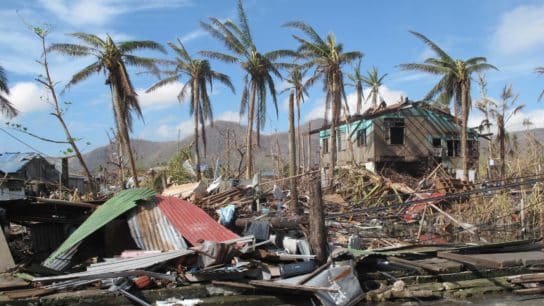An attribution study found that climate change intensified the extreme and deadly winds and rainfall generated by Typhoon Gaemi, which battered the Philippines, Taiwan and eastern China in July.
—
A typhoon that swept across the Philippines, Taiwan and China’s Hunan province in late July was intensified by fossil fuel-driven global warming, a new analysis has found.
Typhoon Gaemi left more than 100 people dead and a trail of destruction across the three Asian countries. Sustained winds peaked at 145 mph (233 km/h) – the equivalent of a Category 4 hurricane – before the typhoon slammed into Taiwan.
World Weather Attribution (WWA), an academic collaboration studying extreme event attribution, said on Thursday that Gaemi’s winds were about 9 mph (14 km/h) or 7% more intense due to human-made climate change.
The typhoon brought huge amounts of rainfall, too. The Philippines, which was not in Gaemi’s path, saw its seasonal rains exacerbated by the typhoon’s influence, triggering devastating floods that killed 34 people. It made a second landfall in eastern China, leading to heavy flooding, mudflows, and landslides. At least 50 people were confirmed dead, with 15 others still missing as of August 20.
While it could not determine how climate change influenced rainfall in the Philippines, WWA concluded that the rainfall that hit Taiwan and China’s Hunan province was made about 14% and 9% heavier, respectively.
Typhoons – also known as hurricanes in the North Atlantic, central North Pacific, and eastern North Pacific and cyclones in the Indian Ocean and South Pacific – are a rather common weather phenomenon, though there has been a significant increase in their intensity in recent decades, which scientific observations link to anthropogenic climate change.
These abnormal trends are attributed largely to the increased ocean temperatures. As ocean surfaces warm, so does the air above it, causing water to be carried up to high altitudes to form clouds, while leaving a low pressure zone beneath causing more air to rush in. As these systems build up, thunderstorms are formed. In the absence of strong winds to disrupt it, the system can intensify into a typhoon.
While the number of typhoons is not necessarily increasing, those that do form are becoming more destructive – generating heavier rain and a higher storm surge.
According to WWA’s study, the warm sea surface temperatures that fuelled Gaemi would have been “virtually impossible” without anthropogenic climate change.
The world’s seas have been exceptionally warm for more than a year. The average sea surface temperature last month reached 20.88C, the second-highest value on record and only 0.01C shy of the value recorded in July 2023. This put an end to a 15-month period of record-breaking sea surface temperatures. The latest temperature trends makes it “increasingly likely” that 2024 will be the warmest year yet, beating last year, according to the EU weather agency Copernicus.
“Fossil fuel-driven warming is ushering in a new era of bigger, deadlier typhoons,” said Ben Clarke, Researcher at the London Imperial College’s Grantham Institute for Climate Change and the Environment. Clarke also warned that Asia will become increasingly inhospitable and dangerous “until fossil fuels are replaced with renewable energy.”
In April, the WMO said Asia was hit hardest by climate change in 2023, with a total of 79 water hazard-related disasters that killed more than 2,000 people and directly affected 9 million people. The UN agency also found that nearly half of all 984,263 climate and natural disaster-related deaths over the past five decades occurred in Asia, with tropical cyclones claiming the highest number of lives.
This story is funded by readers like you
Our non-profit newsroom provides climate coverage free of charge and advertising. Your one-off or monthly donations play a crucial role in supporting our operations, expanding our reach, and maintaining our editorial independence.
About EO | Mission Statement | Impact & Reach | Write for us














